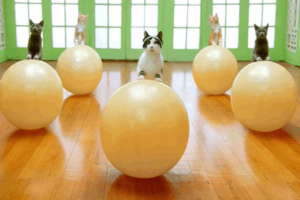Cats and Weight Gain

If your rolly polly butterball is putting on the pounds, he or she is at risk for serious medical issues including diabetes, heart conditions (hypertrophic cardiomyopathy, which is a thickening of the heart muscle that is very serious), and degenerative joint conditions. Overweight cats may have a certain cuteness to them, but this is outweighed by the health risks.
Why do some cats put on the pounds?
But the question is why is your Budha putting on weight? Are you overfeeding, or could something else be at work? The answer lies at the intersection of hunger, appetite, metabolism, exercise, and calories. If any combination of these concepts is out of balance, various problems can occur including excessive weight gain. Some cats are super food needy, even food aggressive and if they don’t get as much food as they want, they can become aggressive or loud complainers. There can be various reasons for this food neediness, and if medical causes have been ruled out (examples being worms or metabolic imbalances) then it could go back to environmental causes like being weaned too early, lack of adequate nutrition early in life, or having to compete for food on the street. A lack of exercise can contribute and exercising will not only help burn calories but will help improve a cat’s metabolism. One Fast Cat makes a great exercise wheel, but just playing with your cat, or walking them on a harness can help.
How to tell if your cat is overweight?

Some cats are obviously chunky, but a better way to tell more precisely how your husky cat is doing is to consult your vet. But even before doing that you can consult a body condition chart (BCS) which scores your cat on a 1-9 scale, 5 being ideal. Having a digital baby scale on hand is a great way to track your cat’s weight with precision. You may say to yourself, “Well I just get on my scale with my cat and compare it to my weight and I have a good idea how much he weighs. But with a baby scale you can see changes by the ounce or fraction of an ounce and that can reveal trends well before you notice them on your scale or in an annual vet visit. More importantly, if the trend (defined as 2 changes in a row in the same direction after taking a base weight) is downward, you may have caught a medical condition very early. In the case of trending weight loss that is not intentional, a vet visit is always in order.
How to slim down your couch potato

How much food is too much? The problem with the portion recommendations on cat food containers is that the manufacturer is assuming that their food is the only food you’re feeding your tubby tuba, and you may be feeding a combination of wet food, dry food, and treats, and if you follow the recommendations for all of them, then you’re likely overfeeding. This is why it’s good to get a recommendation from your vet. You can also get diet foods that replace some of the calories with non-digestible fiber. Putting your cat on a feeding schedule and avoiding free feeding may help as well. Also, the better the quality of protein, the greater its bioavailability which means more nutrients are absorbed and as a result, our cat doesn’t need to eat as much to get its protein needs met. In other words, if your cat needs to eat a lot of lower-quality protein to get its protein needs met, then he is also consuming more fat and carbs than needed. And exercise, exercise, exercise your cat! Every bit helps.
Lastly, helping your cat lose weight under the guidance of a vet is important for a number of reasons, not the least of which is that too fast a loss can lead to something called hepatic lipidosis, or fatty liver disease and this condition is very serious. Kitty can’t wear a Fitbit, but if you pay attention to all these tips you will be helping your cat regain her svelte self! 

By Stephen Quandt
Copyright © Stephen Quandt, 2023, All Rights Reserved | Email: [email protected] | Instagram: @CatBehaviorHelp
